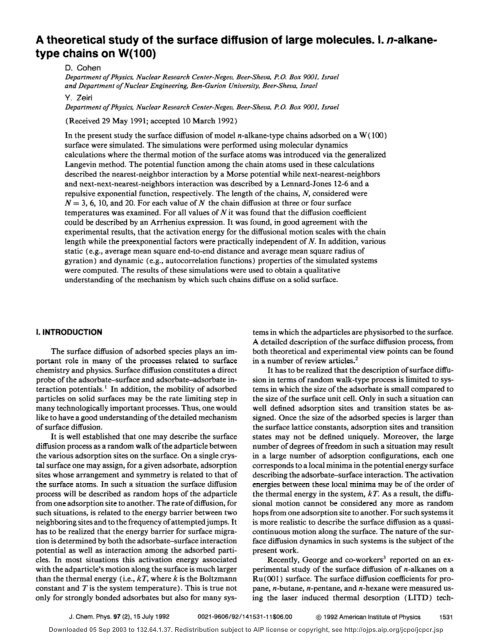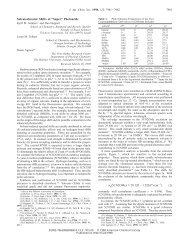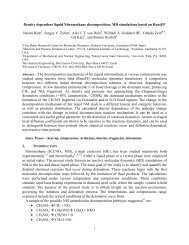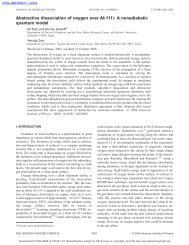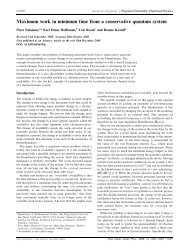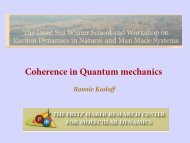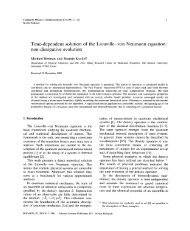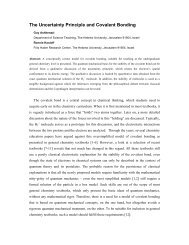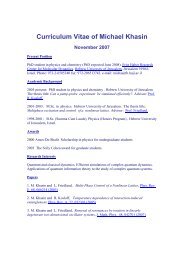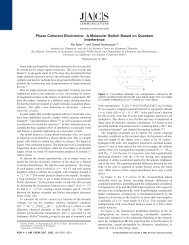A theoretical study of the surface diffusion of - The Fritz Haber ...
A theoretical study of the surface diffusion of - The Fritz Haber ...
A theoretical study of the surface diffusion of - The Fritz Haber ...
You also want an ePaper? Increase the reach of your titles
YUMPU automatically turns print PDFs into web optimized ePapers that Google loves.
A <strong><strong>the</strong>oretical</strong> <strong>study</strong> <strong>of</strong> <strong>the</strong> <strong>surface</strong> <strong>diffusion</strong> <strong>of</strong> large molecules. I. n-alkane-<br />
type chains on W( 100)<br />
D. Cohen<br />
Department <strong>of</strong> Physics, Nuclear Research Center-Negev, Beer-Sheva, P.O. Box 9001, Israel<br />
and Department <strong>of</strong> Nuclear Engineering, Ben-Gurion University. Beer-Sheva, Israel<br />
Y. Zeiri<br />
Department <strong>of</strong> Physics, Nuclear Research Center-Negev, Beer-Sheva, P.O. Box 9001, Israel<br />
(Received 29 May 1991; accepted 10 March 1992)<br />
In <strong>the</strong> present <strong>study</strong> <strong>the</strong> <strong>surface</strong> <strong>diffusion</strong> <strong>of</strong> model n-alkane-type chains adsorbed on a W( 100)<br />
<strong>surface</strong> were simulated. <strong>The</strong> simulations were performed using molecular dynamics<br />
calculations where <strong>the</strong> <strong>the</strong>rmal motion <strong>of</strong> <strong>the</strong> <strong>surface</strong> atoms was introduced via <strong>the</strong> generalized<br />
Langevin method. <strong>The</strong> potential function among <strong>the</strong> chain atoms used in <strong>the</strong>se calculations<br />
described <strong>the</strong> nearest-neighbor interaction by a Morse potential while next-nearest-neighbors<br />
and next-next-nearest-neighbors interaction was described by a Lennard-Jones 12-6 and a<br />
repulsive exponential function, respectively. <strong>The</strong> length <strong>of</strong> <strong>the</strong> chains, N, considered were<br />
N = 3,6, 10, and 20. For each value <strong>of</strong> N <strong>the</strong> chain <strong>diffusion</strong> at three or four <strong>surface</strong><br />
temperatures was examined. For all values <strong>of</strong> N it was found that <strong>the</strong> <strong>diffusion</strong> coefficient<br />
could be described by an Arrhenius expression. It was found, in good agreement with <strong>the</strong><br />
experimental results, that <strong>the</strong> activation energy for <strong>the</strong> <strong>diffusion</strong>al motion scales with <strong>the</strong> chain<br />
length while <strong>the</strong> preexponential factors were practically independent <strong>of</strong> N. In addition, various<br />
static (e.g., average mean square end-to-end distance and average mean square radius <strong>of</strong><br />
gyration) and dynamic (e.g., autocorrelation functions) properties <strong>of</strong> <strong>the</strong> simulated systems<br />
were computed. <strong>The</strong> results <strong>of</strong> <strong>the</strong>se simulations were used to obtain a qualitative<br />
understanding <strong>of</strong> <strong>the</strong> mechanism by which such chains diffuse on a solid <strong>surface</strong>.<br />
1. INTRODUCTION<br />
<strong>The</strong> <strong>surface</strong> <strong>diffusion</strong> <strong>of</strong> adsorbed species plays an im-<br />
portant role in many <strong>of</strong> <strong>the</strong> processes related to <strong>surface</strong><br />
chemistry and physics. Surface <strong>diffusion</strong> constitutes a direct<br />
probe <strong>of</strong> <strong>the</strong> adsorbate-<strong>surface</strong> and adsorbate-adsorbate in-<br />
teraction potentials.’ In addition, <strong>the</strong> mobility <strong>of</strong> adsorbed<br />
particles on solid <strong>surface</strong>s may be <strong>the</strong> rate limiting step in<br />
many technologically important processes. Thus, one would<br />
like to have a good understanding <strong>of</strong> <strong>the</strong> detailed mechanism<br />
<strong>of</strong> <strong>surface</strong> <strong>diffusion</strong>.<br />
It is well established that one may describe <strong>the</strong> <strong>surface</strong><br />
<strong>diffusion</strong> process as a random walk <strong>of</strong> <strong>the</strong> adparticle between<br />
<strong>the</strong> various adsorption sites on <strong>the</strong> <strong>surface</strong>. On a single crys-<br />
tal <strong>surface</strong> one may assign, for a given adsorbate, adsorption<br />
sites whose arrangement and symmetry is related to that <strong>of</strong><br />
<strong>the</strong> <strong>surface</strong> atoms. In such a situation <strong>the</strong> <strong>surface</strong> <strong>diffusion</strong><br />
process will be described as random hops <strong>of</strong> <strong>the</strong> adparticle<br />
from one adsorption site to ano<strong>the</strong>r. <strong>The</strong> rate <strong>of</strong> <strong>diffusion</strong>, for<br />
such situations, is related to <strong>the</strong> energy barrier between two<br />
neighboring sites and to <strong>the</strong> frequency <strong>of</strong> attempted jumps. It<br />
has to be realized that <strong>the</strong> energy barrier for <strong>surface</strong> migra-<br />
tion is determined by both <strong>the</strong> adsorbate-<strong>surface</strong> interaction<br />
potential as well as interaction among <strong>the</strong> adsorbed parti-<br />
cles. In most situations this activation energy associated<br />
with <strong>the</strong> adparticle’s motion along <strong>the</strong> <strong>surface</strong> is much larger<br />
than <strong>the</strong> <strong>the</strong>rmal energy (i.e., kT, where k is <strong>the</strong> Boltzmann<br />
constant and T is <strong>the</strong> system temperature). This is true not<br />
only for strongly bonded adsorbates but also for many sys-<br />
tems in which <strong>the</strong> adparticles are physisorbed to <strong>the</strong> <strong>surface</strong>.<br />
A detailed description <strong>of</strong> <strong>the</strong> <strong>surface</strong> <strong>diffusion</strong> process, from<br />
both <strong><strong>the</strong>oretical</strong> and experimental view points can be found<br />
in a number <strong>of</strong> review articles.*<br />
It has to be realized that <strong>the</strong> description <strong>of</strong> <strong>surface</strong> diffu-<br />
sion in terms <strong>of</strong> random walk-type process is limited to sys-<br />
tems in which <strong>the</strong> size <strong>of</strong> <strong>the</strong> adsorbate is small compared to<br />
<strong>the</strong> size <strong>of</strong> <strong>the</strong> <strong>surface</strong> unit cell. Only in such a situation can<br />
well defined adsorption sites and transition states be as-<br />
signed. Once <strong>the</strong> size <strong>of</strong> <strong>the</strong> adsorbed species is larger than<br />
<strong>the</strong> <strong>surface</strong> lattice constants, adsorption sites and transition<br />
states may not be defined uniquely. Moreover, <strong>the</strong> large<br />
number <strong>of</strong> degrees <strong>of</strong> freedom in such a situation may result<br />
in a large number <strong>of</strong> adsorption configurations, each one<br />
corresponds to a local minima in <strong>the</strong> potential energy <strong>surface</strong><br />
describing <strong>the</strong> adsorbate-<strong>surface</strong> interaction. <strong>The</strong> activation<br />
energies between <strong>the</strong>se local minima may be <strong>of</strong> <strong>the</strong> order <strong>of</strong><br />
<strong>the</strong> <strong>the</strong>rmal energy in <strong>the</strong> system, kT. As a result, <strong>the</strong> diffu-<br />
sional motion cannot be considered any more as random<br />
hops from one adsorption site to ano<strong>the</strong>r. For such systems it<br />
is more realistic to describe <strong>the</strong> <strong>surface</strong> <strong>diffusion</strong> as a quasi-<br />
continuous motion along <strong>the</strong> <strong>surface</strong>. <strong>The</strong> nature <strong>of</strong> <strong>the</strong> sur-<br />
face <strong>diffusion</strong> dynamics in such systems is <strong>the</strong> subject <strong>of</strong> <strong>the</strong><br />
present work.<br />
Recently, George and co-workers3 reported on an ex-<br />
perimental <strong>study</strong> <strong>of</strong> <strong>the</strong> <strong>surface</strong> <strong>diffusion</strong> <strong>of</strong> n-alkanes on a<br />
Ru (00 1) <strong>surface</strong>. <strong>The</strong> <strong>surface</strong> <strong>diffusion</strong> coefficients for pro-<br />
pane, n-butane, n-pentane, and n-hexane were measured us-<br />
ing <strong>the</strong> laser induced <strong>the</strong>rmal desorption (LITD) tech-<br />
J. Chem. Phys. 97 (2), 15 July 1992 0021-9606/92/141531-11$06.00 @ 1992 American Institute <strong>of</strong> Physics 1531<br />
Downloaded 05 Sep 2003 to 132.64.1.37. Redistribution subject to AIP license or copyright, see http://ojps.aip.org/jcpo/jcpcr.jsp
1532<br />
nique.4 It was found that for all <strong>the</strong> above adsorbates <strong>the</strong><br />
<strong>diffusion</strong> coefficient could be described by an Arrhenius be-<br />
havior. Moreover, <strong>the</strong> <strong>surface</strong> <strong>diffusion</strong> activation energies<br />
obtained increased linearly with carbon chain length, while<br />
<strong>the</strong> preexponential factors remained nearly constant. <strong>The</strong>se<br />
measurements also indicated that <strong>the</strong> <strong>surface</strong> <strong>diffusion</strong> coef-<br />
ficients were coverage independent. In addition, <strong>the</strong> <strong>surface</strong><br />
corrugation ratio (i.e., <strong>the</strong> ratio between <strong>the</strong> energy barriers<br />
for <strong>diffusion</strong> and desorption) was observed to have a con-<br />
stant value for all adsorbates considered.3 Similar studies <strong>of</strong><br />
<strong>the</strong> <strong>surface</strong> <strong>diffusion</strong> <strong>of</strong> a number <strong>of</strong> o<strong>the</strong>r organic molecules<br />
have been reported by <strong>the</strong> same group.5<br />
In <strong>the</strong> present work we shall describe molecular dynam-<br />
ics simulations <strong>of</strong> <strong>the</strong> <strong>surface</strong> <strong>diffusion</strong> <strong>of</strong> chain like mole-<br />
cules. <strong>The</strong> length <strong>of</strong> <strong>the</strong> chains, N, in <strong>the</strong> calculations was<br />
varied in <strong>the</strong> range N = 3 up to N = 20. Since <strong>the</strong> interaction<br />
potentials among <strong>the</strong> chain atoms as well as between <strong>the</strong><br />
chain and <strong>the</strong> <strong>surface</strong> are unknown for realistic <strong>surface</strong>-ad-<br />
sorbate systems, we employed model potential functions to<br />
describe <strong>the</strong> system. Thus, <strong>the</strong> emphasis in <strong>the</strong> present <strong>study</strong><br />
is on <strong>the</strong> qualitative understanding <strong>of</strong> <strong>the</strong> <strong>surface</strong> <strong>diffusion</strong><br />
mechanism <strong>of</strong> chain like adsorbates ra<strong>the</strong>r than a quantita-<br />
tive description <strong>of</strong> a realistic system. In order to simplify <strong>the</strong><br />
calculations <strong>the</strong> chain was assumed to consist <strong>of</strong> carbonlike<br />
atoms while <strong>the</strong> hydrogen atoms were not included in <strong>the</strong><br />
calculation. This approximation greatly reduces <strong>the</strong> amount<br />
<strong>of</strong> computer time needed for <strong>the</strong> simulations and is not very<br />
likely to alter significantly <strong>the</strong> qualitative behavior <strong>of</strong> <strong>the</strong><br />
adsorbed chain on <strong>the</strong> <strong>surface</strong>. This approximation will be<br />
tested in a future <strong>study</strong> in which <strong>the</strong> hydrogen atoms will be<br />
included. In <strong>the</strong> calculations described below a single ad-<br />
sorbed chain was considered, namely, <strong>the</strong> low coverage limit<br />
was assumed. In <strong>the</strong> next section <strong>the</strong> <strong><strong>the</strong>oretical</strong> model used<br />
in <strong>the</strong> calculations will be described, while Sec. III is devoted<br />
to <strong>the</strong> description and discussion <strong>of</strong> <strong>the</strong> results. In <strong>the</strong> last<br />
section a short summary will be given.<br />
II. THEORETICAL MODEL<br />
D. Cohen and Y. Zeiri: Surface <strong>diffusion</strong> <strong>of</strong> large molecules. I<br />
<strong>The</strong> aim <strong>of</strong> <strong>the</strong> present work was to <strong>study</strong> <strong>the</strong> mecha-<br />
nism <strong>of</strong> <strong>surface</strong> <strong>diffusion</strong> for n-alkane-type chains adsorbed<br />
on a W ( 100) <strong>surface</strong> at <strong>the</strong> low coverage limit where adsor-<br />
bate-adsorbate interactions may be ignored. <strong>The</strong> simula-<br />
tions were carried out using <strong>the</strong> molecular dynamics ap-<br />
proach where <strong>the</strong> generalized Langevin method (GLE) ,6*7<br />
was used to describe <strong>the</strong> <strong>the</strong>rmal motion <strong>of</strong> <strong>the</strong> <strong>surface</strong><br />
atoms. <strong>The</strong> W ( 100) <strong>surface</strong> was represented by a slab <strong>of</strong> 169<br />
atoms arranged as a single layer <strong>of</strong> 13 X 13 atoms. This slab<br />
constituted <strong>the</strong> “primary zone” with which <strong>the</strong> adsorbed<br />
chain was strongly interacting. <strong>The</strong> rest <strong>of</strong> <strong>the</strong> crystal was<br />
represented by 22 1 fictitious particles which surrounded <strong>the</strong><br />
slab and which were attached to primary zone atoms whose<br />
bonds to atoms outside this zone were truncated. According<br />
to <strong>the</strong> standard GLE approach, <strong>the</strong> slab atoms motions were<br />
described by Newtonian equations <strong>of</strong> motion<br />
ff= ~~‘CdRS,R,) ~‘V,,UVLR,)<br />
JR* - dR2<br />
+ fds,<br />
(1)<br />
J. Chem. Phys., Vol. 97, No. 2,15 July 1992<br />
where R, S, and X are vectors containing <strong>the</strong> positions <strong>of</strong> <strong>the</strong><br />
slab atoms, <strong>the</strong> fictitious particles, and <strong>the</strong> chain atoms, re-<br />
spectively. In Eq. ( 1) R, represents a vector which contains<br />
<strong>the</strong> positions <strong>of</strong> a number <strong>of</strong> solid atoms which were fixed at<br />
<strong>the</strong>ir lattice point. <strong>The</strong>se atoms were added in order to obtain<br />
realistic interaction potentials for both slab and adsorbate<br />
atoms near <strong>the</strong> primary zone edges. <strong>The</strong>se fixed solid atoms<br />
were added as two additional layers around <strong>the</strong> primary<br />
zone and below it. Notice that <strong>the</strong> coordinates <strong>of</strong> all <strong>the</strong> par-<br />
ticles in <strong>the</strong> system are mass weighted coordinates. <strong>The</strong> first<br />
two terms on <strong>the</strong> right-hand side <strong>of</strong> Eq. ( 1) represent <strong>the</strong><br />
forces due to slab atom-slab atom and slab atom-adsorbate<br />
atom interactions, respectively, while <strong>the</strong> last term repre-<br />
sents <strong>the</strong> force due to <strong>the</strong> coupling <strong>of</strong> <strong>the</strong> slab atoms to <strong>the</strong><br />
fictitious particles. Similarly, <strong>the</strong> motion <strong>of</strong> <strong>the</strong> chain atoms<br />
was described by<br />
g = _ ~f’,OGWo) WrxW<br />
ax - ax ’<br />
while <strong>the</strong> motion <strong>of</strong> <strong>the</strong> fictitious particles is described by<br />
i$ = - a?$ +zifR, -ps, +J;(t). (3)<br />
Equation (3) describes <strong>the</strong> motion <strong>of</strong> <strong>the</strong> ith fictitious parti-<br />
cle which is coupled to <strong>the</strong> ith slab atom where <strong>the</strong> first term<br />
represents a self-force constant and <strong>the</strong> second term is a har-<br />
monic coupling to <strong>the</strong> slab atom. <strong>The</strong> last two terms in Eq.<br />
(3) correspond to a friction-type dissipation and a random<br />
force, respectively. <strong>The</strong>se two terms are related by <strong>the</strong> sec-<br />
ond fluctuation-dissipation <strong>the</strong>orem<br />
(f(WVN) = 2kT’,&f), (4)<br />
where k is <strong>the</strong> Boltzmann constant, Tis <strong>the</strong> <strong>surface</strong> tempera-<br />
ture, p is <strong>the</strong> friction constant, and S represents a delta func-<br />
tion. All <strong>the</strong> coefficients in Bq. (3) may be obtained from <strong>the</strong><br />
<strong>surface</strong> phonon spectra and if one uses <strong>the</strong> Debye model<br />
<strong>the</strong>se constants are given in terms <strong>of</strong> <strong>the</strong> Debye frequency,<br />
w,, . A more detailed description <strong>of</strong> <strong>the</strong> GLE approach can<br />
be found in Refs. 6 and 7. It should be noted that similar (as<br />
well as less accurate) approximations to describe <strong>the</strong> solid<br />
<strong>surface</strong> were used in <strong>the</strong> <strong>study</strong> <strong>of</strong> various <strong>surface</strong> related<br />
processes. 7(a)*8 It is believed that this approximate treat-<br />
ment <strong>of</strong> <strong>the</strong> <strong>surface</strong> atoms motion does not influence <strong>the</strong><br />
qualitative behavior <strong>of</strong> <strong>the</strong> adsorbate during <strong>the</strong> calculation<br />
<strong>of</strong> <strong>the</strong> trajectories. Moreover, a more accurate description <strong>of</strong><br />
<strong>the</strong> <strong>surface</strong> motion (i.e., <strong>the</strong> use <strong>of</strong> more than a single layer<br />
for <strong>the</strong> primary zone) would result in a large increase <strong>of</strong> <strong>the</strong><br />
time required for <strong>the</strong> computations which did not seem to be<br />
justified due to <strong>the</strong> approximate description <strong>of</strong> <strong>the</strong> adsorbate<br />
(discussed above) and <strong>the</strong> model potentials used to describe<br />
<strong>the</strong> system (see discussion below).<br />
In Eqs. ( 1) and (2) three different potential functions<br />
were defined namely, V,, , V,, and V,,. <strong>The</strong>se potentials<br />
represent <strong>the</strong> interactions in and between <strong>the</strong> two subsys-<br />
tems, namely, <strong>the</strong> <strong>surface</strong> and <strong>the</strong> adsorbate. As discussed<br />
above, <strong>the</strong> interaction potential between n-alkane adsorbates<br />
and a metal <strong>surface</strong> are not available in <strong>the</strong> literature. More-<br />
over, <strong>the</strong> internal (e.g., chain atom-chain atom) potential <strong>of</strong><br />
such adsorbates probably undergoes marked changes as<br />
compared to a gas phase molecule. This modification <strong>of</strong> <strong>the</strong><br />
Downloaded 05 Sep 2003 to 132.64.1.37. Redistribution subject to AIP license or copyright, see http://ojps.aip.org/jcpo/jcpcr.jsp<br />
(2)
internal chain potential function due to <strong>the</strong> presence <strong>of</strong> <strong>the</strong><br />
solid <strong>surface</strong> is also unknown. Thus, <strong>the</strong> various potential<br />
functions were constructed using <strong>the</strong> available data on such<br />
systems and served as model potentials (see discussion be-<br />
low). Although such model potential functions are not ex-<br />
pected to yield quantitative information about a given sys-<br />
tem it is believed that <strong>the</strong>y will help to obtain a reliable<br />
qualitative description <strong>of</strong> <strong>the</strong> <strong>surface</strong> <strong>diffusion</strong> <strong>of</strong> chainlike<br />
molecules.<br />
<strong>The</strong> potential among <strong>the</strong> <strong>surface</strong> atoms, V,, , was given<br />
as a sum <strong>of</strong> pairwise Lennard-Jones (L-J) ( 12-6) potentials<br />
where <strong>the</strong> sum contained nearest and next-nearest-neighbor<br />
interactions. <strong>The</strong> values <strong>of</strong> <strong>the</strong> two parameters for <strong>the</strong> L-J<br />
function, ERR = 24.63 kcal/mol and a,, = 2.56 A, were<br />
taken from <strong>the</strong> work <strong>of</strong> Halicioglu and Pound.’ This form <strong>of</strong><br />
<strong>the</strong> potential function describing <strong>the</strong> interaction among <strong>the</strong><br />
slab atoms has been used successfully in previous work.’<br />
<strong>The</strong> potential describing <strong>the</strong> interaction among <strong>the</strong><br />
chain atoms, V,,, was assumed to be given also by a sum <strong>of</strong><br />
pairw&e interactions. <strong>The</strong> interaction potential between<br />
nearest-neighbor chain atoms was described by a Morse<br />
function where <strong>the</strong> parameters correspond to those <strong>of</strong> a C-C<br />
bond. <strong>The</strong> actual values used in <strong>the</strong> calculation were<br />
D, = 109.6 kcal/mol, w, = 1854.71 cm-‘, and R, = 1.526<br />
A. <strong>The</strong> interaction between next-nearest-neighbor atoms<br />
was described by an L-J ( 12-6) potential whose parameters<br />
were E = 1.0 kcal/mol and (T = 2.259 A. <strong>The</strong>se values were<br />
chosen in such a way that <strong>the</strong> equilibrium distance between<br />
next-nearest-neighbors was 2.536 A and <strong>the</strong> corresponding<br />
angle between <strong>the</strong> two C-C bonds was 112.4 deg. <strong>The</strong> inter-<br />
action among third order neighbors in <strong>the</strong> chain was as-<br />
sumed to be described by a repulsive exponential function <strong>of</strong><br />
<strong>the</strong> form A -exp( - a-X,), where X,, is <strong>the</strong> distance between<br />
next-next-nearest-neighbors iand jand <strong>the</strong> values <strong>of</strong> <strong>the</strong> two<br />
parameters were A = 100 kcal/mol and a = 2.0 A - ‘. This<br />
repulsive term was introduced in order to reduce <strong>the</strong> folding<br />
<strong>of</strong> <strong>the</strong> chain on itself. For more distant neighbors in <strong>the</strong> chain<br />
<strong>the</strong> interaction was assumed to be zero. Thus <strong>the</strong> potential<br />
V,, was calculated by<br />
v,Y,Y =I v.(xl -xi*l) + C vLJCxi -xX,*2)<br />
n’n “‘“‘”<br />
+ 2 Kx,(Xi-Xx,*3), (5)<br />
It.“‘“‘”<br />
where <strong>the</strong> three potential functions on <strong>the</strong> right-hand side <strong>of</strong><br />
Eq. (5)) VM, Vu, and Vexp represent Morse, L-J, and <strong>the</strong><br />
repulsive exponential potentials, respectively. <strong>The</strong> internal<br />
chain potential described above does not take into account<br />
<strong>the</strong> rotational energy barriers which occur in such n-alkane-<br />
type molecules when next-nearest-neighbor C-C bonds are<br />
rotated. <strong>The</strong> elimination <strong>of</strong> <strong>the</strong>se rotational barriers served<br />
mainly to simplify V,, and reduce <strong>the</strong> computer time need-<br />
ed for <strong>the</strong> simulations. In addition, this approximation may<br />
be justified by <strong>the</strong> fact that <strong>the</strong> energetics involved in <strong>the</strong><br />
rotational motion <strong>of</strong> one C-C bond relative to <strong>the</strong> o<strong>the</strong>r in<br />
<strong>the</strong> adsorbed phase is probably quite different than <strong>the</strong> corre-<br />
sponding value <strong>of</strong> an isolated gas phase molecule. Since <strong>the</strong><br />
D. Cohen and Y. Zeiri: Surface <strong>diffusion</strong> <strong>of</strong> large molecules. I 1533<br />
J. Chem. Phys., Vol. 97, No. 2, 15 July 1992<br />
variation <strong>of</strong> <strong>the</strong>se rotational barriers in <strong>the</strong> adsorbed phase is<br />
unknown we decided to ignore it in <strong>the</strong> present calculations.<br />
Finally, we did not find in <strong>the</strong> literature data related to<br />
<strong>the</strong> interaction <strong>of</strong> n-alkanes with a W( 100) <strong>surface</strong> except<br />
<strong>the</strong> work <strong>of</strong> Yates and Madey on <strong>the</strong> adsorption <strong>of</strong> methane<br />
on W( 100).lo In this <strong>study</strong> it was found that below 110 K<br />
methane adsorbs to <strong>the</strong> W <strong>surface</strong> molecularly with a bind-<br />
ing energy <strong>of</strong> 6.9 kcal/mol. However, no information about<br />
<strong>the</strong> adsorption site <strong>of</strong> molecular methane or its <strong>diffusion</strong> bar-<br />
rier were reported. In addition, data related to <strong>the</strong> binding<br />
energy <strong>of</strong> methane on o<strong>the</strong>r metal <strong>surface</strong>s such as rho-<br />
dium’ ’ and nickel” exhibit lower values <strong>of</strong> binding energies<br />
(e.g., 5 and 2.9 kcal/mol, respectively). Inspection <strong>of</strong> <strong>the</strong><br />
desorption energies, Edes, obtained for propane, butane, pen-<br />
tane, and hexane adsorbed on <strong>the</strong> Ru (00 1) <strong>surface</strong>3 shows<br />
that <strong>the</strong> values <strong>of</strong> Edes do not vary linearly with chain length.<br />
<strong>The</strong> lack <strong>of</strong> experimental information related to <strong>the</strong> details <strong>of</strong><br />
<strong>the</strong> n-alkane/W( 100) interaction forced us to use a model<br />
potential function to describe this interaction. <strong>The</strong> form <strong>of</strong><br />
V, chosen to be used in <strong>the</strong> present <strong>study</strong> was a sum <strong>of</strong><br />
individual chain atom-<strong>surface</strong> interaction where each one <strong>of</strong><br />
<strong>the</strong> chain atoms was assumed to interact with <strong>the</strong> nearest<br />
four W atoms via L-J potentials. Thus, <strong>the</strong> adsorbate-sur-<br />
face interaction potential was given by<br />
VRX= i i VuCXi --Rj), (6)<br />
i=l j=1<br />
where <strong>the</strong> index i runs over <strong>the</strong> chain atoms and <strong>the</strong> index j<br />
runs over <strong>the</strong> four nearest <strong>surface</strong> atoms for each ith chain<br />
atom. <strong>The</strong> values <strong>of</strong> <strong>the</strong> L-J parameters used in <strong>the</strong> calcula-<br />
tions were ERX = 0.722 kcal/mol and a,, = 2.67 16 A. For a<br />
single chain atom over <strong>the</strong> three symmetry sites <strong>of</strong> <strong>the</strong><br />
W( 100) <strong>surface</strong> (when <strong>the</strong> <strong>surface</strong> atoms are fixed at <strong>the</strong>ir<br />
lattice points) <strong>the</strong> binding energies and equilibrium dis-<br />
tances as obtained using this potential were Eb = 0.91,<br />
1.735, and 2.89 kcal/mol and R, = 2.95, 2.5, and 2.0 A for<br />
<strong>the</strong> on-top, bridge and fourfold sites, respectively.<br />
Each trajectory started by placing <strong>the</strong> n-alkane-type<br />
chain along <strong>the</strong> <strong>surface</strong> where all chain atoms were posi-<br />
tioned 2 A above <strong>the</strong> <strong>surface</strong>. <strong>The</strong> distances between <strong>the</strong><br />
chain atoms were chosen to correspond to <strong>the</strong> equilibrium<br />
distances, namely, 2.536 A. <strong>The</strong> initial velocities <strong>of</strong> <strong>the</strong> chain<br />
atoms as well as those <strong>of</strong> <strong>the</strong> slab atoms were chosen from a<br />
Boltzmann distribution at <strong>the</strong> <strong>surface</strong> temperature. Each<br />
trajectory started by an equilibration process, namely, <strong>the</strong><br />
equations <strong>of</strong> motion were integrated for 3000-4000 integra-<br />
tion steps (i.e., 3-4 ps) . This equilibration process was ter-<br />
minated when <strong>the</strong> average kinetic energy <strong>of</strong> <strong>the</strong> particles in<br />
<strong>the</strong> system was < 4 deg <strong>of</strong>f <strong>the</strong> required <strong>surface</strong> temperature<br />
(during a period <strong>of</strong> 1 ps). <strong>The</strong> positions and velocities after<br />
this initialization procedure were used as initial conditions<br />
for <strong>the</strong> trajectory. A trajectory was terminated if it exceeded<br />
40 000 integration steps (i.e., 40 ps) or if <strong>the</strong> adsorbate<br />
moved out <strong>of</strong> <strong>the</strong> slab boundaries. In some cases <strong>the</strong> ad-<br />
sorbed molecule desorbed from <strong>the</strong> <strong>surface</strong>, such trajectories<br />
were restarted. For each Nvalue and given <strong>surface</strong> tempera-<br />
ture ten trajectories were calculated.<br />
Downloaded 05 Sep 2003 to 132.64.1.37. Redistribution subject to AIP license or copyright, see http://ojps.aip.org/jcpo/jcpcr.jsp
1534 D. Cohen and Y. Zeiri: Surface <strong>diffusion</strong> <strong>of</strong> large molecules. I<br />
III. RESULTS AND DISCUSSION<br />
<strong>The</strong> present calculations were devoted to <strong>the</strong> <strong>study</strong> <strong>of</strong><br />
<strong>the</strong> <strong>surface</strong> <strong>diffusion</strong> <strong>of</strong> single n-alkane-type molecules ad-<br />
sorbed on a W ( 100) <strong>surface</strong>, namely, <strong>the</strong> low coverage limit<br />
was considered. <strong>The</strong> calculations were performed for four<br />
chain lengths, N = 3,6,10, and 20. For each chain 34 sur-<br />
face temperatures were considered in <strong>the</strong> range 300-1000 K.<br />
<strong>The</strong>se relatively high temperatures were chosen in order to<br />
be able to obtain reliable <strong>diffusion</strong> coefficients during <strong>the</strong><br />
limited time that could be simulated by molecular dynamics.<br />
For each case, given N value and <strong>surface</strong> temperature, we<br />
calculated ten trajectories. <strong>The</strong> results <strong>of</strong> <strong>the</strong>se trajectories<br />
were used to obtain various averaged quantities and time<br />
correlation functions <strong>of</strong> <strong>the</strong> adsorbed chain. <strong>The</strong> main goal<br />
was to obtain both static and dynamic behavior <strong>of</strong> chain like<br />
molecules adsorbed on a solid <strong>surface</strong>. <strong>The</strong> remainder <strong>of</strong> this<br />
section will be subdivided into four parts which are devoted<br />
to <strong>the</strong> discussion <strong>of</strong> <strong>the</strong> <strong>diffusion</strong> coefficient, <strong>the</strong> static prop-<br />
erties <strong>of</strong> <strong>the</strong> adsorbate, chain relaxation properties, and to a<br />
qualitative description <strong>of</strong> <strong>the</strong> <strong>surface</strong> <strong>diffusion</strong> mechanism <strong>of</strong><br />
adsorbed chains.<br />
A. Diffusion coefficient<br />
<strong>The</strong> <strong>diffusion</strong> coefficients <strong>of</strong> <strong>the</strong> various chains consid-<br />
ered were calculated according to <strong>the</strong> Einstein formula using<br />
<strong>the</strong> mean quadratic displacement <strong>of</strong> <strong>the</strong> chain’s center-<strong>of</strong>-<br />
massI<br />
D= t~,u/4)([x,,(~o -l) -&M(~o)]2)N,~f9<br />
where ( ) Nt represents an average over <strong>the</strong> time steps during<br />
<strong>the</strong> trajectory and X,, is <strong>the</strong> position vector <strong>of</strong> <strong>the</strong> center-<strong>of</strong>-<br />
mass <strong>of</strong> <strong>the</strong> chain. <strong>The</strong> value <strong>of</strong> <strong>the</strong> <strong>diffusion</strong> constant, D, was<br />
obtained as <strong>the</strong> average <strong>of</strong> <strong>the</strong> values obtained in <strong>the</strong> ten<br />
trajectories. <strong>The</strong> natural logarithms <strong>of</strong> <strong>the</strong> resulting values <strong>of</strong><br />
D were plotted as a function <strong>of</strong> l/Tas shown in Fig. 1. It is<br />
clear from <strong>the</strong> linear relationship between In(D) and l/T<br />
that <strong>the</strong> <strong>diffusion</strong> coefficients can be described by an Arrhen-<br />
ius form<br />
-5.5 , I<br />
-13.5<br />
0 N=lO<br />
x N-20<br />
t<br />
-15.5 ’ I<br />
0 0.5 1 1.5 2 2.5 3<br />
1000/T [Kj<br />
FIG. 1. Arrhenius plot showing <strong>the</strong> temperature dependence <strong>of</strong> <strong>the</strong> <strong>surface</strong><br />
<strong>diffusion</strong> coefficients for <strong>the</strong> four chainlike molecules examined.<br />
(7)<br />
D=D,exp -- ,<br />
J. Chem. Phys., Vol. 97, No. 2,15 July 1992<br />
where Do and Edi are <strong>the</strong> preexponential factor and activa-<br />
tion energy for <strong>diffusion</strong>, respectively. <strong>The</strong> values <strong>of</strong> Do and<br />
Ediff for <strong>the</strong> four chains studied are shown in Table I. <strong>The</strong><br />
two additional quantities shown in Table I are <strong>the</strong> activation<br />
energy for desorption, Ed=, and <strong>the</strong> <strong>surface</strong> corrugation ra-<br />
tio defined by fi = E,,/E,,. <strong>The</strong> magnitude <strong>of</strong> Edes was<br />
estimated by <strong>the</strong> following procedure: <strong>the</strong> adsorbate<strong>surface</strong><br />
interaction potential was monitored during <strong>the</strong> evolution <strong>of</strong><br />
<strong>the</strong> trajectory. <strong>The</strong> value <strong>of</strong> this potential which corresponds<br />
to <strong>the</strong> largest binding energy <strong>of</strong> <strong>the</strong> adsorbate to <strong>the</strong> <strong>surface</strong><br />
was designated as Eda. <strong>The</strong> activation energies for desorp-<br />
tion quoted in Table I correspond to <strong>the</strong> average <strong>of</strong> <strong>the</strong> Ed,..<br />
values obtained in <strong>the</strong> 30-40 different trajectories calculated<br />
for any given chain length (<strong>the</strong>se averages correspond to <strong>the</strong><br />
results <strong>of</strong> ten trajectories at any given T considered). <strong>The</strong>re<br />
are a few points which should be emphasized, first, in all<br />
cases Eq. (8) describes accurately <strong>the</strong> dependence <strong>of</strong> D on<br />
<strong>the</strong> <strong>surface</strong> temperature. However, <strong>the</strong> variation <strong>of</strong> D as a<br />
function <strong>of</strong> N cannot be described by a simple scaling de-<br />
pendence. Inspection <strong>of</strong> Table I shows that <strong>the</strong> values <strong>of</strong> both<br />
EdiR and Edes increase with increasing chain length, how-<br />
ever, <strong>the</strong> ratio between <strong>the</strong>se two activation energies remains<br />
almost constant (see values <strong>of</strong> R in Table I). Moreover, <strong>the</strong><br />
values <strong>of</strong> <strong>the</strong> preexponential factors for <strong>the</strong> different chains<br />
seem to be independent <strong>of</strong> <strong>the</strong> value <strong>of</strong> N. Inspection <strong>of</strong> <strong>the</strong><br />
magnitude <strong>of</strong> <strong>the</strong> activation energies for <strong>diffusion</strong> indicate<br />
that this quantity is much more sensitive to <strong>the</strong> magnitude <strong>of</strong><br />
N. To obtain a more quantitative relation between Edif (and<br />
Edes ) and Na log-log plot <strong>of</strong> <strong>the</strong>se quantities is shown in Fig.<br />
2. <strong>The</strong> linear relationship between ln( activation energy) and<br />
ln( N) indicates that one may write a scaling law <strong>of</strong> <strong>the</strong> form<br />
EAc = CNv, (9)<br />
where EAc = EdiF or Ed=. <strong>The</strong> value <strong>of</strong> <strong>the</strong> scaling exponent<br />
obtained from <strong>the</strong> slopes <strong>of</strong> <strong>the</strong> best fits to <strong>the</strong> calculated<br />
results (<strong>the</strong> lines) shown in Fig. 2 are Y = 0.565 & 0.074<br />
(with intercept C = 1.014 f 0.11) and Y = 0.7 + 0.06<br />
(with intercept C = 3.353 + 0.28) for activation energies <strong>of</strong><br />
<strong>diffusion</strong> and desorption, respectively. <strong>The</strong>se results are in<br />
good qualitative agreement with <strong>the</strong> experimental data <strong>of</strong><br />
Ref. 3. <strong>The</strong> experimental <strong>study</strong> was related to variation <strong>of</strong><br />
chain length from N = 3 to 6. In this range <strong>of</strong> N values<br />
TABLE I. Preexponential coefficients and activation energies for <strong>diffusion</strong><br />
as obtained from <strong>the</strong> Arrhenius plot (Fig. 1) toge<strong>the</strong>r with <strong>the</strong> values <strong>of</strong> <strong>the</strong><br />
activation energy for desorption and <strong>the</strong> corrugation ratio, R = EdlR/Ede..<br />
Units <strong>of</strong> D,, in cm*/s and <strong>of</strong> <strong>the</strong> activation energies in kcal/mol.<br />
N DO E dll7 E @!n n<br />
3 (9.45 f 1.38) x lo-’ 1.161 f 0.2 6.93 + 0.11 0.255<br />
6 (6.69 f 2.25) x 10 - 4 2.955 f 0.5 12.05 f 0.09 0.245<br />
10 (2.39f0.116)~10-’ 4.077kO.06 18.24kO.14 0.224<br />
20 (1.49 f 0.24) x 10 - 3 5.111 *0.70 25.81 + 0.21 0.198<br />
Downloaded 05 Sep 2003 to 132.64.1.37. Redistribution subject to AIP license or copyright, see http://ojps.aip.org/jcpo/jcpcr.jsp<br />
(8)
0<br />
0 0.5 1 1.5 2 2.5 3<br />
In(N)<br />
FIG. 2. A log-log plot <strong>of</strong> <strong>the</strong> <strong>surface</strong> <strong>diffusion</strong> activation energy and activa-<br />
tion energy for desorption as a function <strong>of</strong> <strong>the</strong> chain length.<br />
George and co-workers found that <strong>the</strong> magnitude <strong>of</strong> De was<br />
practically constant while <strong>the</strong> magnitude <strong>of</strong> Edie increased<br />
linearly with N. In addition, <strong>the</strong> experimental values ob-<br />
tained for R showed that <strong>the</strong> corrugation ratio remained<br />
constant for all n-alkanes studied. Inspection <strong>of</strong> <strong>the</strong> values<br />
for Do, Edif, and fi for <strong>the</strong> N values considered here (in<br />
Table I) shows that <strong>the</strong> magnitude <strong>of</strong> D,, is practically inde-<br />
pendent <strong>of</strong> <strong>the</strong> chain length. In addition, both activation en-<br />
ergies can be accurately fitted by a linear function <strong>of</strong> Nif only<br />
<strong>the</strong> first three values are considered (i.e., those <strong>of</strong> N = 3, 6,<br />
and IO). However, Eq. (9) results in a much better fit than a<br />
linear one if <strong>the</strong> activation energies for N = 20 are added.<br />
<strong>The</strong>se results suggest that for relatively short adsorbates a<br />
linear relationship exists between <strong>the</strong> two activation energies<br />
and <strong>the</strong> chain length, once longer chains are considered de-<br />
viations <strong>of</strong> linearity are observed. A comparison <strong>of</strong> <strong>the</strong> R<br />
values for N = 3 and 6 (in Table I) shows that <strong>the</strong>se two<br />
corrugation ratios are N independent as observed in <strong>the</strong> ex-<br />
perimental studies. <strong>The</strong> scaling laws obtained for <strong>the</strong> activa-<br />
tion energies for <strong>diffusion</strong> and desorption suggest that <strong>the</strong><br />
D. Cohen and Y. Zeiri: Surface <strong>diffusion</strong> <strong>of</strong> large molecules. I 1535<br />
<strong>surface</strong> corrugation ratio in <strong>the</strong> present calculations is relat-<br />
ed to Nby 0 = 0.303~N -o.136.<br />
B. Static properties <strong>of</strong> adsorbed chain<br />
In order to understand <strong>the</strong> static properties <strong>of</strong> <strong>the</strong> ad-<br />
sorbed chains on <strong>the</strong> solid <strong>surface</strong> we have calculated <strong>the</strong><br />
mean quadratic distance between <strong>the</strong> end atoms in <strong>the</strong> chain<br />
(end-to-end distance)<br />
(R2) = ((Xl --XN12)N, (10)<br />
and <strong>the</strong> mean quadratic radius <strong>of</strong> gyration<br />
(l/N) 2 (X, - Xc, )I) ,<br />
i= 1 N,<br />
(11)<br />
where Xi is <strong>the</strong> position vector <strong>of</strong> chain atom i and Xc, is<br />
given by<br />
X CM = (l/N) 5 X,.<br />
i= 1<br />
TABLE II. <strong>The</strong> values obtained for (R ‘),(S’), and <strong>the</strong> ratio between <strong>the</strong>m toge<strong>the</strong>r with <strong>the</strong> timeconstant for<br />
<strong>the</strong> initial decay <strong>of</strong> C( V,, , t) for <strong>the</strong> various N values and <strong>surface</strong> temperatures.<br />
N T(K) (R*) (A*) (S2) (A? (R ‘)/W Ty (ps) x 102<br />
3 300 6.67 f 0.13 1.26 + 0.015 5.24 &- 0.04<br />
5.2 f 0.4<br />
450 6.39 + 0.05 1.23 f 0.005 5.14 f 0.015<br />
7.7 + 0.2<br />
600 6.31 k 0.03 1.22 f 0.003 5.11 f 0.01<br />
7.5 f 0.2<br />
800 6.33 + 0.065<br />
1.23 f 0.008 5.098 f 0.02<br />
11.0*0.05<br />
6 300 31.11 + 1.27<br />
4.13 f 0.09 7.42 * 0.17<br />
4.3 * 0.4<br />
450 30.23 f 0.6 4.12 * 0.04 7.18 f 0.09<br />
4.9 * 0.3<br />
@xl 26.73 + 0.4 3.91 + 0.03 6.62 f 0.06<br />
6.3 k 0.3<br />
800 27.26 + 0.4 3.94 + 0.03 6.72 f 0.065 10.6 * 0.2<br />
IO 300 85.62 * 5.6 10.17 * 0.4 8.12 + 0.37<br />
450 67.96 f 4.5 9.03 f 0.3 6.9 + 0.35 7.4 f 0.2<br />
600 73.02 k 1.3<br />
9.42+0.11 7.34 + 0.08<br />
8.1 f 0.1<br />
800 58.83 + 2.4<br />
8.35 f 0.19 6.53 * 0.17<br />
9.5 + 0.2<br />
20 600 276.06 + 10.1<br />
31.79 f 0.1 8.32 f 0.23<br />
5.7 f 0.2<br />
800 211.3 f 16.4<br />
26.81 f 1.2 7.18 f 0.34<br />
9.6 * 0.2<br />
1000 158.25 f 10.6<br />
22.18 f 0.77 6.29 f 0.3<br />
12.4 f 0.2<br />
(12)<br />
In Table II we present <strong>the</strong> results for (R ‘) and (S’) and <strong>the</strong><br />
ratio between <strong>the</strong>se two quantities as obtained for <strong>the</strong> differ-<br />
ent chain lengths and <strong>surface</strong> temperatures. Note that <strong>the</strong>se<br />
results correspond to an additional average over <strong>the</strong> (R “)<br />
and (S’) values obtained in <strong>the</strong> ten trajectories calculated<br />
for each Nand Tpair. Inspection <strong>of</strong> <strong>the</strong> results shows that for<br />
a given value <strong>of</strong> N> 3 both (R “) and (S’) decrease for in-<br />
creasing temperatures. For N = 3 both quantities seems to<br />
be independent <strong>of</strong> <strong>the</strong> temperature in <strong>the</strong> range considered.<br />
<strong>The</strong> constant (R ‘) and (S ‘) values obtained for N = 3 are<br />
related to <strong>the</strong> relatively small configuration space available<br />
for such a short chain. In o<strong>the</strong>r words, for N = 3 <strong>the</strong> vari-<br />
ation in <strong>the</strong> magnitude <strong>of</strong> <strong>the</strong> end-to-end distance, R,, , and<br />
in <strong>the</strong> radius <strong>of</strong> gyration, S,, are mainly due to <strong>the</strong> bending<br />
mode <strong>of</strong> <strong>the</strong> adsorbate. Since <strong>the</strong> variation <strong>of</strong> <strong>the</strong> magnitude<br />
<strong>of</strong> bending oscillations for increasing values <strong>of</strong> T is small<br />
both R,,, and S, are practically constant. In <strong>the</strong> case <strong>of</strong> long-<br />
er adsorbates, <strong>the</strong> decreasing values <strong>of</strong> (R “) and (S’) for<br />
J. Chem. Phys., Vol. 97, No. 2, 15 July 1992<br />
Downloaded 05 Sep 2003 to 132.64.1.37. Redistribution subject to AIP license or copyright, see http://ojps.aip.org/jcpo/jcpcr.jsp
1536 D. Cohen and Y. Zeiri: Surface <strong>diffusion</strong> <strong>of</strong> large molecules. I<br />
(a)<br />
(b)<br />
FIG. 3. Adsorption configurations for two chains at T= 600 K. (a) N= 6 and (R ‘) = 5.56 A’; (b) N = 6 and (R ‘) = 2.06 A’; (c) N = 20 and<br />
(R ‘) = 473.95 A*; (d) N = 20 and (R ‘) = 96.3 A’. <strong>The</strong>se configurations correspond to <strong>the</strong> largest [(a) and (c)] and smallest [ (b) and (d) ] (R ') values<br />
obtained in two typical trajectories. In order to distinguish between <strong>the</strong> adsorbate and <strong>the</strong> <strong>surface</strong> <strong>the</strong> distance <strong>of</strong> each atom (in <strong>the</strong> adsorbate) from <strong>the</strong><br />
<strong>surface</strong> was multiplied by a factor <strong>of</strong> 1.5. <strong>The</strong> original distances <strong>of</strong> <strong>the</strong>se atoms from <strong>the</strong> <strong>surface</strong> were in <strong>the</strong> range 2.045 A.<br />
increase <strong>of</strong> T is related to <strong>the</strong> occurrence <strong>of</strong> an additional<br />
bending mode associated with <strong>the</strong> bending <strong>of</strong> a segment <strong>of</strong><br />
<strong>the</strong> chain (which may contain a few atoms) with respect to<br />
<strong>the</strong> remainder <strong>of</strong> <strong>the</strong> chain. <strong>The</strong> transition <strong>of</strong> a stretched<br />
chain into a bent configuration is associated with a passage<br />
over an energy barrier (since some <strong>of</strong> <strong>the</strong> chain atoms may be<br />
located at an energetically unfavorable site over <strong>the</strong> <strong>surface</strong>).<br />
It is clear that an increase in <strong>the</strong> <strong>surface</strong> temperature will<br />
correspond to a larger probability to reach such bent config-<br />
urations and hence to a decrease in <strong>the</strong> (R ‘) and (S “) values<br />
obtained. <strong>The</strong> variation <strong>of</strong> R,,, and S, during all <strong>the</strong> trajec-<br />
tories were monitored. <strong>The</strong> configurations <strong>of</strong> two adsorbates<br />
(N = 6 and 20) which correspond to <strong>the</strong> smallest and largest<br />
values <strong>of</strong> R,,, during two typical trajectories at T = 600 K<br />
are shown in Fig. 3. It is clear that large values <strong>of</strong> R,,, are<br />
related to configurations in which <strong>the</strong> adsorbate is basically<br />
stretched along <strong>the</strong> <strong>surface</strong> while it is highly bent in <strong>the</strong> case<br />
<strong>of</strong> small R,,, values.<br />
It has been shown that for unperturbed conditions <strong>the</strong><br />
value <strong>of</strong> (R 2)/(S2) for long chains should be 6.13 As is<br />
evident from Table II in <strong>the</strong> case <strong>of</strong> N = 3 <strong>the</strong> corresponding<br />
value at all temperatures is < 6 while for longer chains this<br />
J. Chem. Phys., Vol. 97, No. 2.15 July 1992<br />
(d)<br />
value is > 6 for all T values. <strong>The</strong>se deviations <strong>of</strong> (R ‘)/ (S “><br />
from <strong>the</strong> free chain value are due to <strong>the</strong> constraints on <strong>the</strong><br />
adsorbate configurations introduced by <strong>the</strong> presence <strong>of</strong> <strong>the</strong><br />
solid <strong>surface</strong>.<br />
In order to obtain a better visualization <strong>of</strong> <strong>the</strong> variation<br />
<strong>of</strong> <strong>the</strong> end-to-end distance and <strong>the</strong> radius <strong>of</strong> gyration we have<br />
plotted in Fig. 4 <strong>the</strong> variation <strong>of</strong> R a,, as a function <strong>of</strong> time as<br />
obtained in two typical trajectories for N = 3 and 20 at sur-<br />
face temperature <strong>of</strong> 600 K. Figure 5 shows similarly <strong>the</strong> vari-<br />
ation <strong>of</strong> S: during <strong>the</strong> same two trajectories. Inspection <strong>of</strong><br />
<strong>the</strong>se plots clearly shows that for N = 3 both R ,‘,, and Si<br />
perform rapid oscillations which correspond to <strong>the</strong> bending<br />
mode <strong>of</strong> <strong>the</strong> triatomic adsorbate (note <strong>the</strong> relatively small<br />
magnitude <strong>of</strong> <strong>the</strong>se oscillations).<br />
It is clear that <strong>the</strong>se oscillations are random in nature<br />
although <strong>the</strong>re are some indications for <strong>the</strong> trapping <strong>of</strong> <strong>the</strong><br />
adsorbate in some contracted configurations. This trapping<br />
process manifests itself in a sudden decrease <strong>of</strong> <strong>the</strong> average<br />
values <strong>of</strong> R zt, and S : which can be observed for example in<br />
Figs. 4(a) and 5 (a) at 17 < t < 20 ps. Similar, however much<br />
more pronounced, trapping occurs in <strong>the</strong> case <strong>of</strong> N = 20<br />
[Figs. 4(b) and 5 (b) 1. Here various trapped configurations<br />
Downloaded 05 Sep 2003 to 132.64.1.37. Redistribution subject to AIP license or copyright, see http://ojps.aip.org/jcpo/jcpcr.jsp
9<br />
6<br />
*-<br />
s<br />
7<br />
8<br />
-g! 6<br />
(4<br />
5<br />
4<br />
3'<br />
I<br />
0 5 10 15 20 25 30 35 40<br />
600<br />
500<br />
400<br />
n-<br />
2%<br />
9'300<br />
"2<br />
200<br />
Time [ps]<br />
100<br />
i,:<br />
0<br />
0 5 10 15 20 25 30 35 40<br />
(b) ime b4<br />
FIG. 4. Variation <strong>of</strong> R & as a function <strong>of</strong> time in two typical trajectories at<br />
T= 60 K for (a) N= 3 and (b) N= 20.<br />
can be observed (corresponding to very small R & and ,!i’i<br />
values) and <strong>the</strong>y may exist for relatively long duration (i.e.,<br />
5- 10 ps ) . <strong>The</strong> large variation in <strong>the</strong> values <strong>of</strong> R zt, and S : for<br />
N = 20 manifests <strong>the</strong> large variety <strong>of</strong> bent configurations in<br />
which <strong>the</strong> adsorbate can be trapped. It should be noted that<br />
for increasing values <strong>of</strong> <strong>the</strong> <strong>surface</strong> temperature <strong>the</strong> probabil-<br />
ity <strong>of</strong> <strong>the</strong> adsorbed molecule to be trapped in a bent configu-<br />
ration is markedly increased (this behavior is clearly exhibit-<br />
ed in <strong>the</strong> decreasing values <strong>of</strong> (R “) and (S2) as T is<br />
increased, see Table II). It has to be emphasized that <strong>the</strong><br />
variation <strong>of</strong> R z,, and S: shown in Figs. 4 and 5 are typical <strong>of</strong><br />
<strong>the</strong> behavior <strong>of</strong> <strong>the</strong> adsorbate on <strong>the</strong> <strong>surface</strong> as observed in<br />
<strong>the</strong> present <strong>study</strong>. <strong>The</strong> large variations in <strong>the</strong> magnitude <strong>of</strong><br />
R z,, and S: obtained for large values <strong>of</strong> N and T demon-<br />
strate <strong>the</strong> various adsorption configurations <strong>the</strong> adsorbate<br />
may reach during its motion on <strong>the</strong> <strong>surface</strong>. <strong>The</strong>se oscilla-<br />
tions are not due to <strong>the</strong> <strong>the</strong>rmalization process <strong>of</strong> <strong>the</strong> adsor-<br />
bate on <strong>the</strong> <strong>surface</strong> which has been discussed above. We have<br />
verified this by initiating a trajectory at low temperature<br />
(i.e., 200 K) and increased it gradually during <strong>the</strong> trajec-<br />
tory. <strong>The</strong> variation in <strong>the</strong> magnitude <strong>of</strong> R z,, and Si in such a<br />
trajectory was minor at <strong>the</strong> beginning and increased appre-<br />
ciably with increase <strong>of</strong> T.<br />
Next <strong>the</strong> dependence <strong>of</strong> (R “) and (S2) on <strong>the</strong> chain<br />
length, N, was examined. In particular, <strong>the</strong> data <strong>of</strong> (R “) and<br />
(S ‘) from Table II were fitted to a power law <strong>of</strong> <strong>the</strong> form<br />
D. Cohen and Y. Zeiri: Surface <strong>diffusion</strong> <strong>of</strong> large molecules. I 1537<br />
1.5<br />
1.4<br />
r 1.3<br />
-&,<br />
(4<br />
1.1<br />
1<br />
0.9 ’<br />
I<br />
0 5 10 15 20<br />
Time [PSI<br />
25 30 35 40<br />
50<br />
45<br />
40<br />
35<br />
s<br />
*c% 30<br />
25<br />
al<br />
15<br />
10<br />
0 5 10 15 20 25 30 35 40<br />
08 Time [ps]<br />
FIG. 5. Variation 0f.S: as a function <strong>of</strong>time in <strong>the</strong> same trajectories as those<br />
.<strong>of</strong>Fig.4for(a) N=3and(b) N=20.<br />
(A “) = C xN”‘, (13)<br />
where A = R or S. <strong>The</strong> results for T = 600 and 800 K are<br />
shown in Fig. 6. It is clear that in all cases a scaling <strong>of</strong> both<br />
(R ‘) and (S2) with chain length exists. Moreover, for each<br />
quantity <strong>the</strong> value <strong>of</strong> y seems to be independent <strong>of</strong> <strong>the</strong> system<br />
temperature. <strong>The</strong> exponents obtained for (R “) and (S2)<br />
were 0.953 f 0.05 and 0.833 f 0.02, respectively. It should<br />
be noted that <strong>the</strong>se values <strong>of</strong> Y were obtained also for <strong>the</strong><br />
lower temperatures considered. Thus, for (R ) practically a<br />
linear dependence on N is obtained while for (S) <strong>the</strong> observed<br />
dependence on chain length deviates from linearity.<br />
For large polymer molecules (N-, c/3 ) a number <strong>of</strong> analytical<br />
and numerical calculations have shown that<br />
(R “) a (S’) a N”‘, where for a two dimensional system<br />
Y = 3/4 while for three-dimensional systems Y = 0.588.14<br />
<strong>The</strong> deviations <strong>of</strong> <strong>the</strong> Y values obtained in <strong>the</strong> present work<br />
from <strong>the</strong> expected ones for very long polymer chains are<br />
related to both <strong>the</strong> small values <strong>of</strong> N considered and to <strong>the</strong><br />
existence <strong>of</strong> a relatively strong interaction between <strong>the</strong><br />
chains and <strong>the</strong> substrate. Indeed, it was verified that when<br />
<strong>the</strong> adsorbed chain is “stretched” along <strong>the</strong> <strong>surface</strong> <strong>the</strong><br />
strongest adsorbate-<strong>surface</strong> interactions are obtained while<br />
bent configurations correspond to a weaker chain-<strong>surface</strong><br />
bonding. It is expected in such a case that <strong>the</strong> existence <strong>of</strong> <strong>the</strong><br />
solid <strong>surface</strong> will tend to “stretch” <strong>the</strong> adsorbate and to yield<br />
J. Chem. Phys., Vol. 97, No. 2,15 July 1992<br />
Downloaded 05 Sep 2003 to 132.64.1.37. Redistribution subject to AIP license or copyright, see http://ojps.aip.org/jcpo/jcpcr.jsp
1538 D. Cohen and Y. Zeiri: Surface <strong>diffusion</strong> <strong>of</strong> large molecules. I<br />
a-<br />
6<br />
-G 4<br />
z<br />
2-<br />
+ Q=Reta T=600<br />
0 C?=Rete T=800<br />
0'<br />
0 1 2 3 4<br />
FIG. 6. <strong>The</strong> variation <strong>of</strong>ln( (R ‘)) and In( (S’)) as a function <strong>of</strong> In(N) for<br />
T=Wand8OOK.<br />
an (R ‘) value which is roughly proportional to N. For much<br />
larger N values, <strong>the</strong> differences in <strong>the</strong> free energies <strong>of</strong> <strong>the</strong><br />
system for “stretched” and “bent” configurations decrease<br />
due to <strong>the</strong> rapid increase in <strong>the</strong> number <strong>of</strong> adsorption states.<br />
Hence, <strong>the</strong> contribution <strong>of</strong> <strong>the</strong>se bent configurations to (R ‘)<br />
will increase and <strong>the</strong> <strong><strong>the</strong>oretical</strong> limit <strong>of</strong> <strong>the</strong> Y valueI is ex-<br />
pected.<br />
C. Chain relaxation<br />
Among <strong>the</strong> many dynamical properties which can be<br />
studied <strong>the</strong> chain relaxation is one which attracted a certain<br />
amount <strong>of</strong> attention.‘3,‘4 <strong>The</strong> relaxation process is charac-<br />
terized by <strong>the</strong> decay <strong>of</strong> <strong>the</strong> time-dependent autocorrelation<br />
functions <strong>of</strong> (R ‘) and (S*). <strong>The</strong>se functions measure <strong>the</strong><br />
extent to which a configuration at time to influences <strong>the</strong> con-<br />
figurations at subsequent times to + t. <strong>The</strong> autocorrelation<br />
function for a scalar property A is defined by<br />
C(A,t) =<br />
WJ)<br />
(A(t,M(to + t,> - (A(to))*<br />
(A(to)*) - (A(to>)* ’<br />
(14)<br />
where A denotes R * or S *. <strong>The</strong> average ( ) should be evalu-<br />
ated as ensemble averages but <strong>the</strong>se ensemble averages may<br />
be replaced by averages over different to values provided that<br />
<strong>the</strong> interval between successive times is sufficiently large for<br />
<strong>the</strong> configurations to be uncorrelated. It is clear from Eq.<br />
(14) that C(A,t = 0) = 1 and <strong>the</strong> correlation function<br />
should be zero for large values <strong>of</strong> t. Typical behavior <strong>of</strong><br />
C(R *,t) and C( S *,t) are shown in Fig. 7 for T = 600 K and<br />
N = 3. In addition <strong>the</strong> behavior <strong>of</strong> <strong>the</strong>se correlation func-<br />
tions for different <strong>surface</strong> temperature values and for N = 3<br />
are shown in Fig. 8 (note that <strong>the</strong> time scale in Fig. 8 is<br />
different than <strong>the</strong> one in Fig. 7). Qualitatively very similar<br />
results were obtained for longer adsorbed chains. Inspection<br />
<strong>of</strong> <strong>the</strong>se results shows that in all cases <strong>the</strong>re exists a very<br />
rapid initial decrease in <strong>the</strong> value <strong>of</strong> C( A,t) during <strong>the</strong> first<br />
0.25 ps which is followed by a much slower relaxation up to<br />
t = 4 ps. <strong>The</strong> rate <strong>of</strong> this slow relaxation exhibits a linear<br />
dependence on <strong>the</strong> time, t. Moreover, Fig. 8 shows that this<br />
slow relaxation rate is practically independent <strong>of</strong> <strong>the</strong> <strong>surface</strong><br />
0.8<br />
0.6<br />
a<br />
"a 0.4<br />
si<br />
(a)<br />
0.2<br />
0.8<br />
0.8<br />
0<br />
"&I 0.4<br />
3<br />
(b)<br />
0.2<br />
0<br />
0 2<br />
2 4 6 8 10<br />
Time [ps]<br />
4 6 8 10<br />
Time [ps]<br />
FIG. 7. <strong>The</strong>variation<strong>of</strong> C(A,t) asafunction<strong>of</strong>timefor T= 600and N = 3,<br />
where (a) A = R * and (b) A = S*.<br />
temperature. <strong>The</strong> variation <strong>of</strong> C(A,t) in <strong>the</strong> range between<br />
t = 1 and 4 ps were examined by a best fit <strong>of</strong> a linear function<br />
to this region for all N and T values. It was found that for<br />
both A = R * and A = S * <strong>the</strong> relaxation time constants, r,., ,<br />
obtained were in <strong>the</strong> range <strong>of</strong> 2-6 ps. No systematic depend-<br />
ence on <strong>the</strong> <strong>surface</strong> temperature (for a given N value) was<br />
observed. Moreover, we could not find any correlation be-<br />
tween 7A and <strong>the</strong> chain length. It should be noted that <strong>the</strong><br />
relatively large values <strong>of</strong> <strong>the</strong> relaxation time constant for<br />
both R * and S* are similar in <strong>the</strong>ir magnitude to periods<br />
during which <strong>the</strong> adsorbate is trapped in <strong>the</strong> various bent<br />
configurations (see discussion above 1.<br />
An additional quantity <strong>of</strong> interest in <strong>the</strong> <strong>study</strong> <strong>of</strong> relaxa-<br />
tion processes in such systems13*‘4 is related to <strong>the</strong> time de-<br />
pendence <strong>of</strong> <strong>the</strong> velocity autocorrelation function <strong>of</strong> <strong>the</strong><br />
chain’s center-<strong>of</strong>-mass. This quantity is defined by<br />
CW,,J) =<br />
J. Chem. Phys., Vol. 97, No. 2,15 July 1992<br />
w,,(to)~v,,(to +t,><br />
w,,cto)*v,,cto)) -<br />
A<br />
(15)<br />
Typical results <strong>of</strong> C(V,, , t) for different <strong>surface</strong> tempera-<br />
tures and for N = 6 are shown in Fig. 9. Analysis <strong>of</strong> <strong>the</strong><br />
variation <strong>of</strong> <strong>the</strong> center-<strong>of</strong>-mass autocorrelation as a function<br />
<strong>of</strong> time shows that for all Tvalues one obtains a fast exponen-<br />
tial decrease <strong>of</strong> C( V cM ,t> followed by a rapid decaying oscil-<br />
lation. It should be noted that <strong>the</strong> oscillations at t values > 1<br />
Downloaded 05 Sep 2003 to 132.64.1.37. Redistribution subject to AIP license or copyright, see http://ojps.aip.org/jcpo/jcpcr.jsp
(a)<br />
.02<br />
0<br />
(b) ’<br />
- T=300<br />
‘.-‘.‘..’ T=450<br />
- T=800<br />
I I<br />
0 1 2 3 4 5<br />
Time [ps]<br />
- T=3OU<br />
““.’ ” T=450<br />
----- T=600<br />
- T=EW<br />
1 2 3 4 5<br />
Time [PCS]<br />
FIG. 8. Same as in Fig. 7 for different <strong>surface</strong> temperatures (note <strong>the</strong> difference<br />
in time scale-s compared to Fig. 7) (a) A = R * and (b) A = S*.<br />
ps are mainly due to noise. Similar shapes <strong>of</strong> C( V,, ,t) were<br />
obtained for o<strong>the</strong>r values <strong>of</strong> N. At <strong>the</strong> lower <strong>surface</strong> tempera-<br />
ture values (T = 300 and 450 K) a negative minimum in<br />
cw cM ,t) is observed. <strong>The</strong>se negative values <strong>of</strong> <strong>the</strong> autocor-<br />
relation function are associated with <strong>the</strong> existence <strong>of</strong> long<br />
lived configurations <strong>of</strong> <strong>the</strong> adsorbate on <strong>the</strong> <strong>surface</strong>. Similar<br />
behavior was observed for isolated polymer chains in solu-<br />
tion ‘3(a)P’5 where <strong>the</strong> negative regions <strong>of</strong> <strong>the</strong> velocity corre-<br />
lation function were associated with <strong>the</strong> cage effect. In <strong>the</strong><br />
present <strong>study</strong> <strong>the</strong> local minima in <strong>the</strong> adsorbate-<strong>surface</strong> po-<br />
tential function are analogous to <strong>the</strong> cage formed by <strong>the</strong> sol-<br />
vent particles in <strong>the</strong> <strong>study</strong> <strong>of</strong> polymer dynamics in solutions.<br />
<strong>The</strong> fast initial decay <strong>of</strong> C( V,, ,t) was fitted to an exponen-<br />
tial function <strong>of</strong> <strong>the</strong> form<br />
a v,, , 0 aexp( - t/r”), (16)<br />
where r” is <strong>the</strong> time constant associated with <strong>the</strong> decay rate<br />
<strong>of</strong> <strong>the</strong> center-<strong>of</strong>-mass velocity correlation function. <strong>The</strong> val-<br />
ues obtained for <strong>the</strong> various T and N values are presented in<br />
<strong>the</strong> last column <strong>of</strong> Table II. <strong>The</strong>se values clearly show that<br />
no obvious scaling law <strong>of</strong> ry as a function <strong>of</strong> N can be estab-<br />
lished. However, <strong>the</strong>re exists a clear dependence <strong>of</strong> <strong>the</strong> relax-<br />
ation time constant on <strong>the</strong> <strong>surface</strong> temperature. It is clear<br />
that <strong>the</strong> magnitude <strong>of</strong> ry increases with increasing values <strong>of</strong><br />
T (see Table II). This variation <strong>of</strong> ry as a function <strong>of</strong> T is<br />
related to <strong>the</strong> trapping <strong>of</strong> <strong>the</strong> adsorbate in highly bent config-<br />
D. Cohen and Y. Zeiri: Surface <strong>diffusion</strong> <strong>of</strong> large molecules. I 1539<br />
I<br />
2<br />
”<br />
0.4 - T=800<br />
z<br />
0 0.2 :<br />
IL<br />
0<br />
i L,<br />
?<br />
if .: I‘.;;, py.<br />
z is<br />
; , s(,:.:<br />
%\‘,V . . ‘i<br />
>1<br />
“- ‘,Y<br />
. .,;> ..--y<br />
-0.2<br />
0.4<br />
Ii<br />
0 1 2 3 4 5<br />
Time [ps]<br />
FIG. 9. Center-<strong>of</strong>-mass velocity autocorrelation as a function <strong>of</strong> time for<br />
N = 6 at various <strong>surface</strong> temperatures.<br />
urations which are associated with relatively high barriers<br />
which <strong>the</strong> molecule has to overcome in order to get into<br />
<strong>the</strong>m. Thus, <strong>the</strong> increase in Tresults in a larger probability <strong>of</strong><br />
<strong>the</strong> adsorbate to reach <strong>the</strong>se bent configurations. However,<br />
once <strong>the</strong>se configurations are reached, <strong>the</strong> adsorbate will be<br />
trapped in <strong>the</strong>m for a relatively long duration. Never<strong>the</strong>less,<br />
no simple functional dependence <strong>of</strong> this time constant on T<br />
was detectable for <strong>the</strong> various values <strong>of</strong> N.<br />
D. Surface <strong>diffusion</strong> mechanism<br />
In this subsection we shall try to establish a general de-<br />
scription <strong>of</strong> <strong>the</strong> detailed mechanism by which n-alkane-type<br />
chains diffuse on solid <strong>surface</strong>s. <strong>The</strong> analysis described be-<br />
low is based on <strong>the</strong> results described above as well as on a<br />
detailed <strong>study</strong> <strong>of</strong> a large number <strong>of</strong> individual trajectories.<br />
This analysis consisted <strong>of</strong> three different and complemen-<br />
tary ways <strong>of</strong> representation <strong>of</strong> <strong>the</strong> adsorbate configurations<br />
on <strong>the</strong> <strong>surface</strong> and <strong>the</strong> variation <strong>of</strong> <strong>the</strong>se configurations dur-<br />
ing <strong>the</strong> trajectory. First we have used drawings <strong>of</strong> <strong>the</strong> adsor-<br />
bate configuration on <strong>the</strong> <strong>surface</strong> (similar to those <strong>of</strong> Fig. 3)<br />
for a number <strong>of</strong> consecutive t values at different stages <strong>of</strong> <strong>the</strong><br />
trajectory. In addition <strong>the</strong> variation <strong>of</strong> <strong>the</strong> three Cartesian<br />
components <strong>of</strong> <strong>the</strong> position vector <strong>of</strong> all <strong>the</strong> atoms in <strong>the</strong><br />
chain were plotted. Finally, <strong>the</strong> variation <strong>of</strong> <strong>the</strong> normal and<br />
parallel components <strong>of</strong> R & [i.e., R zt, (n) and R zt, (p), re-<br />
spectively] as a function <strong>of</strong> time were examined. Typical<br />
results describing <strong>the</strong> variation <strong>of</strong> R z,, (n) and R z,, (p) as a<br />
function <strong>of</strong>t for N = 3 and 6 at T = 600 K are shown in Fig.<br />
10. Inspection <strong>of</strong> Fig. 10 shows that both quantities oscillate<br />
around an average value and <strong>the</strong>re is a strong correlation<br />
between <strong>the</strong>se oscillations. In <strong>the</strong> case <strong>of</strong> N = 3 [Fig. lO( a) ]<br />
any decrease/increase in <strong>the</strong> value <strong>of</strong> R & (n) is compensat-<br />
ed by an increase/decrease in <strong>the</strong> magnitude <strong>of</strong> R $, (p).<br />
Moreover, after a cycle <strong>of</strong> decrease and increase in <strong>the</strong> mag-<br />
nitude <strong>of</strong> R t (p) in most cases <strong>the</strong> ratio between <strong>the</strong> two<br />
components <strong>of</strong> R zt, (p) along <strong>the</strong> <strong>surface</strong> (i.e., along <strong>the</strong> X<br />
and Y directions) were markedly changed. In <strong>the</strong> case <strong>of</strong><br />
N = 6 [Fig. lO( b) ] most <strong>of</strong> <strong>the</strong> oscillations in R 2, (n ) do<br />
not correspond to a marked change in R & (p) (except, for<br />
example, <strong>the</strong> oscillation at t = 3 ps). Similar behavior was<br />
J. Chem. Phys., Vol. 97, No. 2, 15 July 1992<br />
Downloaded 05 Sep 2003 to 132.64.1.37. Redistribution subject to AIP license or copyright, see http://ojps.aip.org/jcpo/jcpcr.jsp
16<br />
Q=Ret&)<br />
0 10 20 30 40<br />
(a) Time [ps]<br />
0 10 20 30 40<br />
lb] Time [ps]<br />
FIG. 10. Variation <strong>of</strong><strong>the</strong> normal (solid line) and parallel (light dotted line)<br />
components <strong>of</strong> R * as a function <strong>of</strong> time for T = 600 K. (a) shows <strong>the</strong> results<br />
for N = 3 [note that <strong>the</strong> curve <strong>of</strong> R :,, (p) was shifted to higher values by 4<br />
A2 to obtain a better resolution <strong>of</strong> <strong>the</strong> two curves] while (b) shows <strong>the</strong><br />
results for N = 6 [here <strong>the</strong> values <strong>of</strong> R z,, (n) were multiplied by 5 while<br />
those <strong>of</strong> R :,. (p) shifted to larger values by 10 A2 to obtain better resolution<br />
between <strong>the</strong> two curves].<br />
observed for o<strong>the</strong>r N values and different <strong>surface</strong> tempera-<br />
tures. For all chains considered, an increase in <strong>the</strong> value <strong>of</strong> T<br />
resulted in an increase in <strong>the</strong> frequency <strong>of</strong> oscillations for<br />
bothR:,,(n) andRzt,(p).<br />
Analysis <strong>of</strong> individual configuration sequences during<br />
<strong>the</strong> oscillations described above, toge<strong>the</strong>r with a detailed ex-<br />
amination <strong>of</strong> <strong>the</strong> variation in <strong>the</strong> positions <strong>of</strong> individual<br />
chain atoms during <strong>the</strong> trajectory suggest that two types <strong>of</strong><br />
basic movements are involved in <strong>the</strong> motion <strong>of</strong> chainlike<br />
molecules on a solid <strong>surface</strong>. <strong>The</strong>se two types <strong>of</strong> movements<br />
may be described by rotational motion <strong>of</strong> relatively small<br />
fragments <strong>of</strong> <strong>the</strong> chain as is shown schematically in Fig. Il.<br />
<strong>The</strong> first type [Fig. 11 (a) ] consists <strong>of</strong> <strong>the</strong> elevation <strong>of</strong> <strong>the</strong><br />
chain edge above <strong>the</strong> <strong>surface</strong> followed by a rotation <strong>of</strong> this<br />
elevated segment around a bond to <strong>the</strong> <strong>surface</strong>. <strong>The</strong> move-<br />
ment ends by lowering <strong>the</strong> segment back to <strong>the</strong> <strong>surface</strong> above<br />
a new position. We shall denote this type <strong>of</strong> movement as<br />
“edge rotation” or ER. <strong>The</strong> second type <strong>of</strong> basic movement<br />
observed, consists <strong>of</strong> <strong>the</strong> elevation <strong>of</strong> a segment located in <strong>the</strong><br />
middle <strong>of</strong> <strong>the</strong> chain above <strong>the</strong> <strong>surface</strong> which results in <strong>the</strong><br />
D. Cohen and Y. Zeiri: Surface <strong>diffusion</strong> <strong>of</strong> large molecules. I<br />
(b]<br />
(a)<br />
J. Chem. Phys., Vol. 97, No. 2,15 July 1992<br />
Edge rotation<br />
central segment rotation<br />
- -<br />
/////////// ///////////<br />
FIG. 11. Schematic description <strong>of</strong> <strong>the</strong> two basic types <strong>of</strong> motion <strong>of</strong> different<br />
chain segments. (a) Edge rotation and (b) central segment rotation.<br />
formation <strong>of</strong> an inverted U shape. Next, this elevated seg-<br />
ment rotates around <strong>the</strong> axis connecting its two edges, hence,<br />
<strong>the</strong> center <strong>of</strong> <strong>the</strong> segment is lowered to <strong>the</strong> <strong>surface</strong> while one<br />
or both edges are elevated, a schematic description <strong>of</strong> such<br />
movement is shown in Fig. 11 (b). In <strong>the</strong> following, this type<br />
<strong>of</strong> movement will be denoted as “central segment rotation”<br />
or CSR. It is clear that <strong>the</strong> CSR is expected to occur only in<br />
<strong>the</strong> case <strong>of</strong> longer chains (i.e., when Nis 2 5) while <strong>the</strong> ER<br />
may take place for any N value. For long chains, both types<br />
<strong>of</strong> movements may occur as well as various combinations <strong>of</strong><br />
<strong>the</strong>m. <strong>The</strong>se two different types <strong>of</strong> segment movements sug-<br />
gest that <strong>the</strong> activation energy for <strong>the</strong> <strong>diffusion</strong>al motion <strong>of</strong><br />
<strong>the</strong> molecule is determined by <strong>the</strong> energy required to elevate<br />
<strong>the</strong> segment from <strong>the</strong> <strong>surface</strong>. Moreover, <strong>the</strong> configuration<br />
which corresponds to an elevated segment (in both ER and<br />
CSR) may be identified with <strong>the</strong> transition state for <strong>the</strong> dif-<br />
fusional motion. It is clear that <strong>the</strong> energy required for <strong>the</strong><br />
elevation process is determined by <strong>the</strong> segment-<strong>surface</strong> in-<br />
teraction as well as <strong>the</strong> interaction among <strong>the</strong> chain atoms.<br />
Thus, <strong>the</strong> <strong>surface</strong> <strong>diffusion</strong> <strong>of</strong> <strong>the</strong> n-alkane-type chains is a<br />
result <strong>of</strong> a sequence <strong>of</strong> <strong>the</strong>se two basic types <strong>of</strong> movements<br />
and <strong>the</strong>ir combinations. According to this mechanism <strong>of</strong><br />
<strong>surface</strong> <strong>diffusion</strong> (which involves <strong>the</strong> two basic movements<br />
described above) it is expected that <strong>the</strong> activation energy for<br />
<strong>diffusion</strong> will not scale linearly with N for chains longer than<br />
a few atoms. However, for short chains, when <strong>the</strong> ER-type<br />
movement dominates <strong>the</strong> <strong>diffusion</strong>al motion a linear rela-<br />
Downloaded 05 Sep 2003 to 132.64.1.37. Redistribution subject to AIP license or copyright, see http://ojps.aip.org/jcpo/jcpcr.jsp
tionship between EdiR and Nmay exist. <strong>The</strong>se results are in a<br />
good qualitative agreement with <strong>the</strong> experimental observa-<br />
ti0ns.j <strong>The</strong> experimental results for n-alkane adsorbates<br />
with Nin <strong>the</strong> range 3-6 indicated that <strong>the</strong> adsorbed molecule<br />
performs a concerted motion along <strong>the</strong> <strong>surface</strong> during its<br />
<strong>surface</strong> <strong>diffusion</strong>. This suggestion is confirmed in <strong>the</strong> present<br />
<strong>study</strong>, namely, <strong>the</strong> motion <strong>of</strong>short chains along <strong>the</strong> <strong>surface</strong> is<br />
dominated by <strong>the</strong> ER-type movement in which <strong>the</strong> rotating<br />
segment includes most <strong>of</strong> <strong>the</strong> atoms in <strong>the</strong> chain. However,<br />
for longer adsorbates, both ER and CSR-types <strong>of</strong> move-<br />
ments contribute to <strong>the</strong> motion <strong>of</strong> <strong>the</strong> adsorbate along <strong>the</strong><br />
<strong>surface</strong> and <strong>the</strong> motion cannot be viewed as a concerted one<br />
anymore.<br />
IV. SUMMARY<br />
<strong>The</strong> present <strong>study</strong> was devoted to <strong>the</strong> investigation <strong>of</strong><br />
<strong>the</strong> nature <strong>of</strong> <strong>surface</strong> <strong>diffusion</strong> <strong>of</strong> n-alkane-type chains on a<br />
solid <strong>surface</strong>. <strong>The</strong> motion <strong>of</strong> a single adsorbate (low cover-<br />
age limit) on a W( 100) <strong>surface</strong> was simulated using <strong>the</strong><br />
GLE approach. <strong>The</strong> calculations were performed for various<br />
chain lengths and a number <strong>of</strong> <strong>surface</strong> temperatures. It was<br />
found that for all values <strong>of</strong> N <strong>the</strong> variation <strong>of</strong> <strong>the</strong> <strong>diffusion</strong><br />
coefficient as a function <strong>of</strong> <strong>surface</strong> temperature could be de-<br />
scribed by an Arrhenius form. Moreover, it was found that<br />
<strong>the</strong> preexponential factor is practically independent <strong>of</strong> <strong>the</strong><br />
chain length while <strong>the</strong> activation energy for <strong>diffusion</strong> was<br />
found to be approximately proportional to <strong>the</strong> square root <strong>of</strong><br />
N. <strong>The</strong>se results are in good agreement with <strong>the</strong> experimen-<br />
tal findings3 except for <strong>the</strong> variation <strong>of</strong> EdiR with IV which<br />
were found experimentally to exhibit a linear relationship.<br />
This difference is attributed to <strong>the</strong> relatively short chains<br />
which were used in <strong>the</strong> experimental <strong>study</strong>.<br />
In addition a number <strong>of</strong> static properties <strong>of</strong> <strong>the</strong> adsorbed<br />
chain were examined. It was found that <strong>the</strong> adsorbates may<br />
be trapped in local minima <strong>of</strong> <strong>the</strong> potential energy <strong>surface</strong><br />
describing <strong>the</strong> chain-<strong>surface</strong> interaction. <strong>The</strong>se trapped con-<br />
figurations may exist for relatively long periods (for 2-10<br />
ps), and hence significantly influence <strong>the</strong> mean square end-<br />
to-end distance and <strong>the</strong> mean square radius <strong>of</strong> gyration <strong>of</strong> <strong>the</strong><br />
adsorbed molecules. Moreover, this trapped configuration<br />
may serve as a cage for <strong>the</strong> adsorbate which is manifested in<br />
<strong>the</strong> existence <strong>of</strong> a negative minima in <strong>the</strong> time autocorrela-<br />
tion function <strong>of</strong> <strong>the</strong> center-<strong>of</strong>-mass velocity.<br />
<strong>The</strong> results obtained in this work allowed us to identify<br />
two different types <strong>of</strong> basic movements which dominate <strong>the</strong><br />
motion <strong>of</strong> <strong>the</strong> adsorbate on <strong>the</strong> <strong>surface</strong>. <strong>The</strong>se correspond to<br />
two different rotational movements <strong>of</strong> segments located at<br />
<strong>the</strong> edge and in <strong>the</strong> middle <strong>of</strong> <strong>the</strong> chain. <strong>The</strong> mechanism <strong>of</strong><br />
D. Cohen and Y. Zeiri: Surface <strong>diffusion</strong> <strong>of</strong> large molecules. I 1541<br />
<strong>surface</strong> <strong>diffusion</strong> <strong>of</strong> n-alkane-type chains is described by a<br />
sequence <strong>of</strong> <strong>the</strong>se two basic movements and <strong>the</strong>ir combina-<br />
tions.<br />
Future work will be devoted to <strong>the</strong> <strong>study</strong> <strong>of</strong> <strong>the</strong> influence<br />
<strong>of</strong> <strong>the</strong> chain rigidity on its <strong>surface</strong> mobility.16<br />
ACKNOWLEDGMENT<br />
This research was supported by <strong>The</strong> Fund for Basic Re-<br />
search Administered by <strong>The</strong> Academy <strong>of</strong> Sciences and Hu-<br />
manities.<br />
‘See, for example, (a) G. Ehrlich and K. Stolt, Annu. Rev. Phys. Chem.<br />
30,603 (1980); (b) D. A. King, J. Vat. Sci. Technol. 17,241 (1980).<br />
*See, for example, (a) A. G. Naumovets and Y. S. Vedula, Surf. Sci. Rep. 4,<br />
365 (1985); (b) R. Gomer, Rep. Prog. Phys. 53,917 (1990).<br />
3J. L. Brand, M. V. Arena, A. A. Deckert, and S. M. George, J. Chem.<br />
Phys. 92,5136 (1990).<br />
‘See, for example, (a) S. M. George, A. M. DeSantolo, and R. B. Hall,<br />
Surf. Sci. 159, L425 ( 1985); (b) C. H. Mac, J. L. Brand, A. A. Deckert,<br />
and S. M. George, J. Chem. Phys. 85, 1676 ( 1986); (c) C. H. Mac, B. G.<br />
Koehler, J. L. Brand, and S. M. George, ibid. 87,234O ( 1987); (d) C. H.<br />
Mac, J. L. Brand, B. G. Koehler, and S. M. George, Surf. Sci. 191, 108<br />
(1987).<br />
’ (a) C. H. Mak, B. G. Koehler, and S. M. George, J. Vat. Sci. Technol. A<br />
6,856 ( 1988); (b) E. D. Westre, M. V. Arena, A. A. Deckert, J. L. Brand,<br />
and S. M. George, Surf. Sci. 233, 293 (1990); (c) M. V. Arena, A. A.<br />
Deckert, J. L. Brand, and S. M. George, J. Phys. Chem. 94,293 ( 1990).<br />
6See, for example, (a) S. A. Adelman and J. D. Doll, J. Chem. Phys. 61,<br />
4242 (1974); (b) S. A. Adelman, ibid. 71,447l (1979); (c) R. R. Luc<strong>the</strong>se<br />
and J. C. Tully, Surf. Sci. 137, 570 (1983).<br />
‘(a) Y. Zeiri, J. J. Low, and W. A. Goddard, J. Chem. Phys. 84, 2408<br />
(1986); (b) Y. Zeiri and R. R. Lucchese, ibid. (in press); (c) Surf. Sci.<br />
(submitted).<br />
‘See, for example, (a) J. C. Tully, G. H. Gilmer, and M. Shugard, J. Chem.<br />
Phys. 71,163O (1979); (b) J. C. Tully, ibid. 73,6333 ( 1980); (c) 73,1975<br />
( 1980); (d) E. K. Grimmelmann, J. C. Tully, and E. Helfand, ibid. 74,<br />
53M) (1981); (e) J. C. Tully, Surf. Sci. 111,461 (1981); (f) G. F. Tantardini<br />
and M. Simonetta, Chem. Phys. Lett. 87, 420 (1982); (g) C. W.<br />
Muhlhausen, L. R. Williams, and J. C. Tully, J. Chem. Phys. 83, 2594<br />
(1985); (h) P. J. van den Hoek, T. C. M. Horn, and A. W. Kleyn, Surf.<br />
Sci. 198, L335 (1988).<br />
9T. Halicioglu and G. M. Pound, Phys. Status Solid A 30,619 (1975).<br />
“J. T. Yates and T. E. Madey, Surf, Sci. 28,437 ( 1971).<br />
“C. N. Stewart and G. Ehrlich, J. Chem. Phys. 62,4672 (1975).<br />
‘*J. D. Beckerle. A. D. Johnson, and S. T. Cever. - Phys. Rev. Lett. 62, 685<br />
(1989).<br />
I3 See, for example, (a) M. Bishop, M. H. Kalos, and H. L. Frisch, J. Chem.<br />
Phys.70,1299(1979);(b)D.C.Rapaport,ibid.71,3299(1979);(c)W.<br />
Bruns and R. Bansal. ibid. 74.2064 ( 1981): ,, Id) .-, J. Luque, J. Santamaria,<br />
and J. J. Freire, ibid.‘91, 584’( 1989).<br />
I4 A. Baumgartner, in Applications <strong>of</strong> <strong>the</strong> Monte Carlo Method in Statistical<br />
Physics, edited by K. Binder (Springer, Berlin, 1984).<br />
“See, for example, J. P. Ryckaert and A. Bellemans, Chem. Phys. Lett. 30,<br />
123 (1975).<br />
I6 D. Cohen and Y. Zeiri (in preparation).<br />
J.Chem. Phys.,Vol. 97,No.2,15 July 1992<br />
Downloaded 05 Sep 2003 to 132.64.1.37. Redistribution subject to AIP license or copyright, see http://ojps.aip.org/jcpo/jcpcr.jsp


